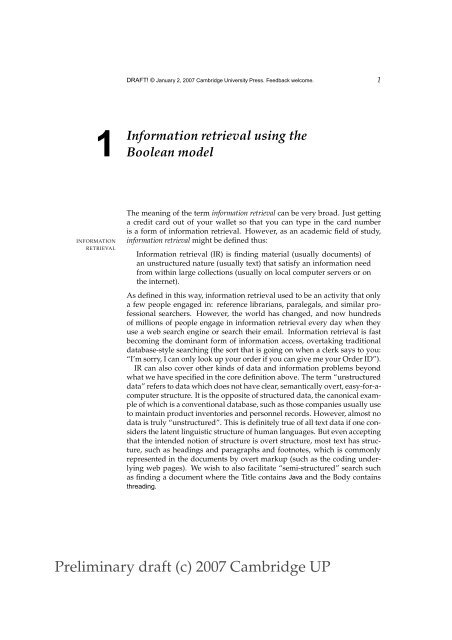Preliminary draft (c) 2007 Cambridge UP - Villanova University
Preliminary draft (c) 2007 Cambridge UP - Villanova University
Preliminary draft (c) 2007 Cambridge UP - Villanova University
You also want an ePaper? Increase the reach of your titles
YUMPU automatically turns print PDFs into web optimized ePapers that Google loves.
DRAFT! © January 2, <strong>2007</strong> <strong>Cambridge</strong> <strong>University</strong> Press. Feedback welcome. 1<br />
1<br />
Information<br />
retrieval using the<br />
Boolean model<br />
INFORMATION<br />
RETRIEVAL<br />
The meaning of the term information retrieval can be very broad. Just getting<br />
a credit card out of your wallet so that you can type in the card number<br />
is a form of information retrieval. However, as an academic field of study,<br />
information retrieval might be defined thus:<br />
Information retrieval (IR) is finding material (usually documents) of<br />
an unstructured nature (usually text) that satisfy an information need<br />
from within large collections (usually on local computer servers or on<br />
the internet).<br />
As defined in this way, information retrieval used to be an activity that only<br />
a few people engaged in: reference librarians, paralegals, and similar professional<br />
searchers. However, the world has changed, and now hundreds<br />
of millions of people engage in information retrieval every day when they<br />
use a web search engine or search their email. Information retrieval is fast<br />
becoming the dominant form of information access, overtaking traditional<br />
database-style searching (the sort that is going on when a clerk says to you:<br />
“I’m sorry, I can only look up your order if you can give me your Order ID”).<br />
IR can also cover other kinds of data and information problems beyond<br />
what we have specified in the core definition above. The term “unstructured<br />
data” refers to data which does not have clear, semantically overt, easy-for-acomputer<br />
structure. It is the opposite of structured data, the canonical example<br />
of which is a conventional database, such as those companies usually use<br />
to maintain product inventories and personnel records. However, almost no<br />
data is truly “unstructured”. This is definitely true of all text data if one considers<br />
the latent linguistic structure of human languages. But even accepting<br />
that the intended notion of structure is overt structure, most text has structure,<br />
such as headings and paragraphs and footnotes, which is commonly<br />
represented in the documents by overt markup (such as the coding underlying<br />
web pages). We wish to also facilitate “semi-structured” search such<br />
as finding a document where the Title contains Java and the Body contains<br />
threading.<br />
<strong>Preliminary</strong> <strong>draft</strong> (c)<strong>2007</strong> <strong>Cambridge</strong> <strong>UP</strong>



